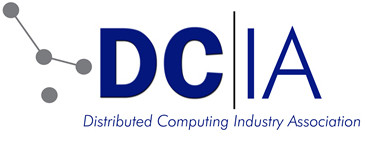In This Issue
- AT&T and Hurricane
- Walmart Taps Cloud
- Verizon Powers SD
- Report from the CEO
- Machine Learning IIoT
- IoT Market and Cloud
- Edge and ML in IoT
- Alibaba’s Cloud Plans
- VA Adopts Framework
- Mobile Cloud Industry
- Cloud Security Alliance
- Protect Against Threat
- Telecom Cloud Future
- Saudi Telecom Cloud
- SMBs Cloud Powerful
- Early Innings for Cloud
- Coming DCIA Events
AT&T Responds to Hurricane Harvey
Excerpted from Multichannel News Report by Jeff Baumgartner
 As part of its response to the effects of Hurricane Harvey, AT&T said it has deployed seven portable cell sites, two charging stations, and an emergency communications vehicle in South Texas.
As part of its response to the effects of Hurricane Harvey, AT&T said it has deployed seven portable cell sites, two charging stations, and an emergency communications vehicle in South Texas.
Per a live blog pertaining to the storm that AT&T is maintaining, the company is also issuing credits to wireless customers in impacted areas (including parts of Louisiana) for additional data, voice and text charges, and to AT&T prepaid subs for additional voice and text charges through at least September 1st.
AT&T, which has also closed all its Houston-area stores, released this statement Monday afternoon:
“We continue to evaluate the affects from Hurricane Harvey, but overall our networks in South Texas continue to perform well so far.
In Houston, historic flooding has affected wireline services for some customers, in addition to some wireless and wireline services in the areas around Corpus Christi, Victoria, and South Houston that have been affected by power outages and other storm damage.
Our technicians are working to restore service to affected areas as quickly and safely as conditions allow… Read More
Walmart Taps Massive Cloud to Take on Amazon
Excerpted from Fortune Report by Barb Darrow
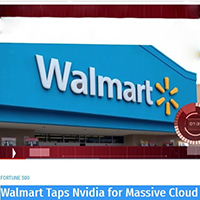 Walmart, which is building its own cloud-based data centers, will be using more – a lot more – Nvidia chips going forward, according to a research note from Global Equities Research.
Walmart, which is building its own cloud-based data centers, will be using more – a lot more – Nvidia chips going forward, according to a research note from Global Equities Research.
In doing so, the retail giant joins a number of cloud computing providers like Amazon Web Services that are using more of what’s known as graphical processing units, or GPUs, to crunch data for machine learning.
GPUs, the thinking goes, are better suited for analyzing huge data sets or controlling autonomous cars than more general-purpose chips that are used for more typical computing.
Over the next six months, Walmart will go “full steam” into deep neural networks, using clusters of Nvidia chips, Global Equities analyst Trip Chowdhry says in a note released Tuesday, which Barrons first spotted.
Neural networks, a subset of artificial intelligence (AI), are sophisticated computing systems that mimic how the human brain learns.
Chowdhry says that Walmart is building a “GPU farm” that will be about a tenth of the size of rival Amazon Web Services “GPU” cloud. He does not identify any sources… Read More
Verizon Cloud Video Unit Powers Stadium Digital
Excerpted from Multichannel News Report by Jeff Baumgartner
 Verizon is now supporting live, on-demand streaming for Stadium Digital’s All Access Platform.
Verizon is now supporting live, on-demand streaming for Stadium Digital’s All Access Platform.
Verizon Digital Media Services said its Uplynk video streaming service is being used to underpin Stadium Digital’s All Access Platform, an OTT service and “digital loyalty and fan engagement platform” in Canada that offers live and VOD programming and game-day highlights.
Stadium Digital works with several leagues in Canada, including the Canadian Hockey League (CHL) and its regional leagues, the Ontario Hockey League (OHL), Quebec Major Junior Hockey League (QMJHL) and Western Hockey League (WHL), as well as several Canadian Football League (CFL) teams, including the Hamilton Tiger-Cats, Toronto Argonauts and Winnipeg Blue Bombers.
In addition to games and highlights, the service also features content for fans and sponsor offers.
VDMS said its Uplynk Video Streaming service will next be used to stream Ticats TV Live coverage of the pregame, halftime, and postgame shows when the Hamilton Tiger-Cats face the Toronto Argonauts on Monday, September 4th.
VDMS partners include Newsy, ABC/Disney, Sinclair Broadcasting Group, Vice, and Hearst Media Group, and go90… Read More
Report from DCIA CEO Marty Lafferty

The DCIA is pleased to partner with Qatalyst Global on Industrial Internet of Things (IoT) Europe taking place November 7th and 8th in Munich, Germany, as part of its Industrial IoT Series.
The Industrial IoT promises to generate a new wave of technological innovation that will permanently redefine the current digital landscape.
Pioneering businesses are connecting complex, physical machines with high-quality analytics to unleash a wealth of new insights that were never before possible.
Companies are looking to leverage the Industrial IoT to reduce unplanned downtime, increase efficiency, and open-up a new era of economic growth and competitiveness.
IoT Europe will bring together forward-thinking companies from the manufacturing, energy, and transportation sectors to pave the way for the Industrial IoT revolution. This event is highly content driven, with an incredibly low vendor-to-delegate ratio, allowing for intimate networking opportunities for every attendee.
Each attendee is encouraged to interact via roundtable discussions, networking sessions, and sit-down meals.
With an extensively researched agenda, tailored to industry specific requirements by a steering committee of industry experts, attendees can expect the most up-to-date topics to be addressed and grasp a real understanding of key issues within their industry.
Share wisely, and take care.
Machine Learning Enhances Value of IIoT
Excerpted from Forbes Report by Jankiram MSV
 Industrial Internet of Things (IIoT) is already revolutionizing domains such as manufacturing, automobiles, and healthcare.
Industrial Internet of Things (IIoT) is already revolutionizing domains such as manufacturing, automobiles, and healthcare.
But the real value of IIoT will be realized only when Machine Learning (ML) is applied to the sensor data. This article attempts to highlight how ML augments IIoT solutions by bringing intelligent insights.
Cloud computing has been the biggest enabler of connected devices and enterprise IoT.
Cheaper storage combined with ample computing power is the key driver behind the rise of IIoT.
Though it was possible to capture data from various sensors and devices, customers found it prohibitively expensive to store massive datasets.
Even after sufficient storage resources were allocated, the computing horse power required to process, query and analyze these datasets was missing in the enterprise data center.
Much of the available resources were allocated to data warehouses and business intelligence systems that are critical to businesses… Read More
IoT Market: Cloud Opens Avenues for Growth
Excerpted from Digital Journal Report
 The global internet of things market is comprised of players of all sizes, with a large chunk of them traditionally based in the area of consumer electronics or internet and communication technologies (ICT), notes Transparency Market Research (TMR).
The global internet of things market is comprised of players of all sizes, with a large chunk of them traditionally based in the area of consumer electronics or internet and communication technologies (ICT), notes Transparency Market Research (TMR).
Some of the leading companies in the global internet of things market are Cisco Systems., Intel, Amazon, Microsoft, Apple, and Google.
Top players in this market focused on acquiring propriety platforms and technologies are at the forefront in developing innovative products, in order to consolidate theirs shares in various regions, observes TMR.
Several players are focused on developing secure technology solutions to gain a competitive edge over others in the IoT value chain.
The estimated valuation of the global internet of things market was $334.22 billion at the end of 2016.
Projected to rise at a substantial CAGR of 20.55% from 2016 to 2024, the revenue of the market is anticipated to reach $1,490.31 billion by the end of the forecast period… Read More
Edge Computing and Machine Learning in IoT
Excerpted from e27 Report by Euleen Chew
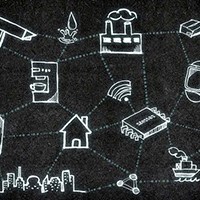 The internet of things (IoT) has been called the next technology revolution after the internet – the dawn of a new era promising exciting possibilities with wearables, smart homes, autonomous cars, smart factories, smart cities and literally anything with “smart” on it.
The internet of things (IoT) has been called the next technology revolution after the internet – the dawn of a new era promising exciting possibilities with wearables, smart homes, autonomous cars, smart factories, smart cities and literally anything with “smart” on it.
The term the “Internet of Things” implies the interconnection of devices — “things” – to the internet and to each other.
The adoption in IoT adoption is opportune due to a combination of underlying trends: cheap and widely available bandwidth; developments in semiconductors that has resulted cheaper, less energy consuming microprocessors; developments in big data analytics tools.
IoT adoption will be enabled by two developing technological trends – edge computing and machine learning.
The proliferation of connected devices, sensors, gateways – IoT endpoints – is under way.
The IT industry analyst, Gartner, estimates a rapid proliferation of IoT endpoints at a rate of 30%, potentially reaching 20 billion by 2020. The implosion of connected devices brings about new challenges… Read More
A Look at Alibaba’s Cloud Computing Plans
Excerpted from Market Realist Report by Naomi Gray
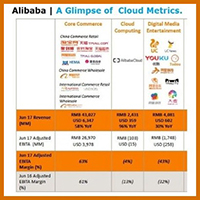 In its cloud push, Alibaba has drawn up a strategy to guide its execution.
In its cloud push, Alibaba has drawn up a strategy to guide its execution.
In that strategy, Alibaba – like most of its cloud competitors such as Amazon, Microsoft, and Alphabet’s Google – is prioritizing growth over profitability.
Despite profits not being the immediate prize, Alibaba is maintaining a focus on running an efficient cloud operation.
Alibaba’s management noted in its earnings statement for fiscal 1Q18, “Market expansion remains our top priority, and we will continue to invest to acquire customers by developing innovative solutions and deploying efficient and cost effective products and services.”
As part of its expansion drive, Alibaba is investing in growing its cloud computing capacity by planting cloud data centers in various regions.
The company recently announced plans to build two new cloud data centers in Malaysia and Indonesia is it doubles down on its efforts to increase its international presence.
Alibaba Cloud is available in 14 countries… Read More
Virginia Adopts Cybersecurity Framework
Excerpted from Statescoop Report by Colin Wood
 In what is just one in a string of recent cybersecurity announcements, Governor Terry McAuliffe declared Thursday that Virginia is the first state to adopt the National Initiative for Cyber Security Education (NICE) Framework, developed by the National Institute of Standards and Technology, in an official capacity.
In what is just one in a string of recent cybersecurity announcements, Governor Terry McAuliffe declared Thursday that Virginia is the first state to adopt the National Initiative for Cyber Security Education (NICE) Framework, developed by the National Institute of Standards and Technology, in an official capacity.
The latest version of the framework – also known as NIST Special Publication 800-181 – was published earlier this month, with the intention of providing a “common, constant lexicon” for a fast-growing industry in which everyone seems to have a different name for the same thing.
The state is not the first to consult the framework, nor is it mandating that any organization within the state use it, but it’s the first state to officially endorse the guideline as an important ingredient for any university, business or government organization interested in supporting a coherent cybersecurity ecosystem.
McAuliffe, a Democrat who has positioned himself as a leader of states-driven cybersecurity initiatives since taking office in 2014, said Virginia’s integration of the NICE Framework into existing hiring and education efforts will help meet the demand for the state’s some 36,000 unfilled cybersecurity positions.
The governor’s announcement makes official and is expected to unify pockets of adoption throughout the state… Read More
Mobile Cloud’s Rising Global Industry
 In its recent report on the global mobile cloud market, Big Market Research highlights changing market dynamics, investment pockets, and recent trends to help market players gain strong foothold in the industry.
In its recent report on the global mobile cloud market, Big Market Research highlights changing market dynamics, investment pockets, and recent trends to help market players gain strong foothold in the industry.
Moreover, the study also offers key driving forces, restraints, and opportunities along with their impact.
Substantial rise in smartphone adoption and advancement of mobile technologies have influenced every sector in the world.
Moreover, increase in application of cloud owing its benefits such as convenience and flexibility of use has become a crucial factor for business organizations to enhance user experience.
Increase in the adoption of bring your own device (BYOD) technology and improved connectivity have eased the access to data. These factors have brought new opportunities for the mobile cloud industry across the globe.
The Department of Veterans Affairs (VA) has identified the benefits of deploying mobile cloud and planning to develop a mobile cloud services (MCS) infrastructure.
It has issued a request for information on potential contractors to support the development… Read More
Cloud Security Alliance to Improve Cybersecurity
Excerpted from CloudTech Report by James Bourne
 As any medical professional will explain, prevention is always better than cure.
As any medical professional will explain, prevention is always better than cure.
So why are so many organizations reactive instead of proactive when it comes to cybersecurity threats?
A new report from the Cloud Security Alliance (CSA) aims to introduce new metrics for enterprises to improve their security game.
The report, titled ‘Improving Metrics in Cyber Resiliency’, introduces Elapsed Time to Identify Failure (ETIF) and Elapsed Time to Identify Threat (ETIT), as well as processes to measure and develop lower values in order to improve the resiliency of an information system.
The research advocates the responsibility for measuring and reporting each metric should be transferred to intrusion detection system (IDS) providers.
The ETIF metric is relatively straightforward to understand.
If one takes the standard graphical representation of a cyberattack, with time as the x-axis… Read More
Cloud Can Protect Firms Against Cyber Threats
Excerpted from CXOtoday Report by Sohini Bagchi
 At a time when cyberattacks are growing worldwide, and high-profile cybercrime such as data theft, ransomware and computer hacks have become the order of the day, experts believe that cloud computing may provide the security against cyberthreats that companies need.
At a time when cyberattacks are growing worldwide, and high-profile cybercrime such as data theft, ransomware and computer hacks have become the order of the day, experts believe that cloud computing may provide the security against cyberthreats that companies need.
They reason that cloud helps security operations respond quicker to threats and focus on business risk as opposed to spending countless hours researching threats and trouble-shooting aging on-premises systems.
It also saves a substantial cost for organizations in the long run.
According to the latest market study released by Technavio, the global cloud security solutions market is expected to grow at a CAGR of close to 20 percent during the forecast period and sectors such as BFSI, retail, healthcare and government can tremendously benefit from migrating to cloud.
For example, Technavio researchers found that the BFSI sector that has been the constant target of web-based attacks over the past years with customers making increasing number of transactions and payments using the internet and web applications, cloud solution can reduce the the risk of identity theft… Read More
Telecom Future Amid Surging Cloud Popularity
Excerpted from TotalCIO Report by Jason Sparapani
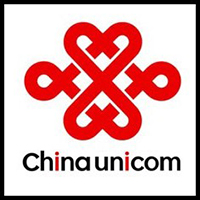 With cloud computing popularity on the ascent, Ben Chen has to think big.
With cloud computing popularity on the ascent, Ben Chen has to think big.
Chen is President of Business Development at a US branch of China Unicom, a state-owned telecom and the second-largest wireless carrier in the world’s most populous country.
I spoke to him at the Gartner Catalyst conference in San Diego, CA earlier this month.
Based in San Jose, CA, Chen’s division helps US companies moving to China get set up with telecommunications, connecting their facilities abroad with stateside headquarters.
And it does the same for Chinese companies building outposts in the US.
With the steep and rapid increase in the number of cloud adopters, especially in the US, Chen wonders, how relevant will a traditional telecom remain to customers?
“Maybe they will rely on more cloud services, because they have all their content on the cloud, and the cloud can be synchronized, so maybe they won’t need real connectivity between China and their headquarters anymore,” Chen said… Read More
Saudi Telecom Creates Cloud Giant
Excerpted from ComputerWeekly Report by Edward Banda
 Saudi Telecom Company (STC) has partnered with state-owned IT company ELM and the National Information Center to create the Saudi Cloud Computing Company, which will drive the transformation of government services.
Saudi Telecom Company (STC) has partnered with state-owned IT company ELM and the National Information Center to create the Saudi Cloud Computing Company, which will drive the transformation of government services.
By grouping resources and focusing on one objective through the Saudi Cloud Computing Company, the joint venture aims to provide all government services under one roof and provide users with a unified experience.
STC, ELM and the National Information Center are addressing this with the alliance launching the Saudi Cloud Computing Company, said Tarig Enaya, Senior Vice President of Enterprise at STC.
“The Saudi Cloud Computing Company leverages the reach of STC’s networks, fixed and mobile, its interconnected data centers, its experience in building cloud ecosystems, and its huge network of technology partners and suppliers,” he said.
STC said the deal is aimed at helping to power the Kingdom of Saudi Arabia’s digitalization strategy and is in line with the country’s National Transformation Program 2020 and Vision 2030.
By having all government services under one roof, hosted locally, ICT infrastructure management is more secure and cost efficient… Read More
Cloud for SMBs a Powerful Solution
Excerpted from Telegraph Report by Sally Percy
 What kind of business has the billing capability of a telecommunications giant, the e-commerce platform of a global online retailer and the security capability of a government agency?
What kind of business has the billing capability of a telecommunications giant, the e-commerce platform of a global online retailer and the security capability of a government agency?
Potentially any kind of business, as it happens.
Today businesses of all sizes are accessing technological capabilities that were once the preserve of large companies simply by tapping into the cloud – an internet-based form of computing where processing resources and data are shared with computers and other devices on demand.
The cloud can be used for a host of business purposes, from storing and sharing documents and data through to accounting, collaboration, file backup, and inspecting web and email traffic for viruses and spyware.
What’s more, it offers substantial cost savings by bundling together application development, infrastructure, maintenance and support services and allowing organizations to only pay for the services that they use.
Unsurprisingly, then, the global cloud services market is estimated to be worth $246.8 billion in 2017, according to analyst Gartner, with cloud adoption strategies likely to influence more than 50 per cent of IT outsourcing deals by 2020… Read More
Only Early Innings for Cloud Computing
Excerpted from Morningstar Report by Bryan Borzykowski
 If you think the opportunities to invest in cloud computing have come and gone, think again.
If you think the opportunities to invest in cloud computing have come and gone, think again.
You may think that most companies would have moved all their business processes to the cloud by now, especially with so many studies showing how much cheaper and more efficient cloud computing technology can be.
In reality, though, the majority of enterprises are still using clunky servers stored on-site or software once installed off a CD-ROM.
In a recent white paper, Morningstar estimated that just 20% to 25% of virtualized infrastructure is running in a public cloud environment.
That’s likely to change.
All three main types of cloud computing markets–software as a service (programs people use), infrastructure as a service (virtual server space), and platform as a service (a virtual environment where companies can test their own apps and programs)–are expected to grow exponentially over the next few years.
“There was a lot of hype around cloud computing a couple of years ago, but we’re still early,” says Margaret Vitrano… Read More
Coming Events of Interest
Industry of Things World Europe — September 18th and 19th in Berlin, Germany. Join more than 1,000 high-level executives to rethink your technology and business strategy for scalable, secure, and efficient IoT.
IoT Solutions World Congress — October 3rd through 5th in Barcelona, Spain. This event has grown enormously in no time and is an excellent barometer and source of information, inspiration, collaboration and transformation.
2017 Storage Visions Conference — October 16th in Milpitas, CA. “New Visions for Digital Storage” will bring together the vendors, end-users, researchers, and visionaries who will meet the growing demand for digital storage for all aspects of unstructured and lightly structured data.
INTRASECT— November 1st and 2nd in Washington, DC. The first conference of its kind to engage key stakeholders in a comprehensive and engaging examination of existing and future regulatory policy governing the usage of commercial autonomous vehicles.
Industrial Internet of Things (IoT) Europe — November 7th and 8th in Munich, Germany. IoT Europe will bring together forward-thinking companies from the manufacturing, energy, and transportation sectors to pave the way for the Industrial IoT revolution.
Government Video Expo & National Drone Show — November 28th-30th in Washington, DC. The 22nd annual GVE will feature a full exhibit floor with numerous training options, free seminars, keynotes, networking opportunities, and five new educational pavilions.
Delivery of Things World 2018 — April 23rd and 24th in Berlin, Germany. Meet the most influential DevOps practitioners and experts and discuss what DevOps means for your business.
